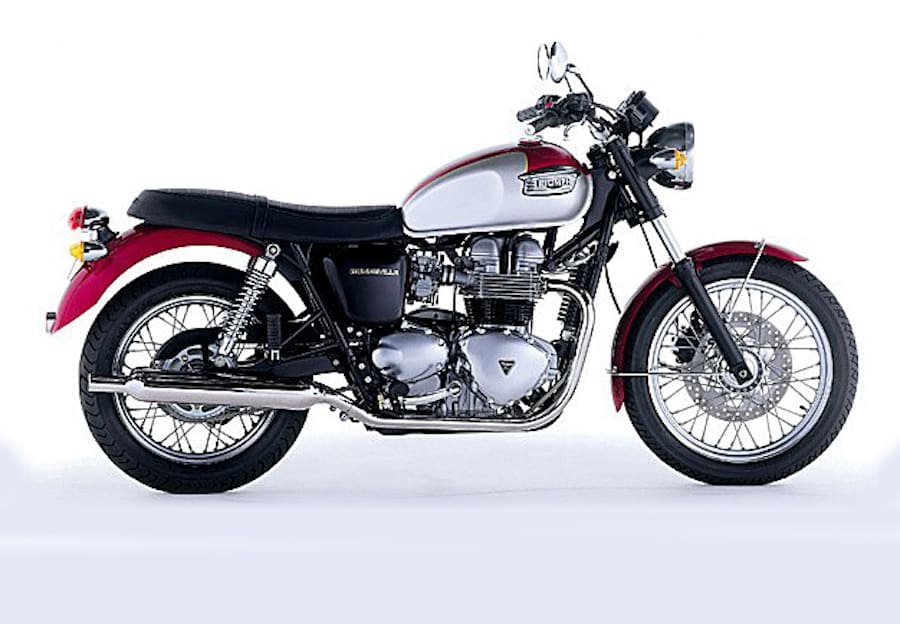While the so-called metric cruisers, mainly from Japanese factories, are labelled pretenders by cruiser purists in the USA, Triumph’s cruisers are considered the real McCoy. During the halcyon customising days of the 1950s and ’60s, Triumph 650cc twins were being chopped and bobbed alongside the home-grown Harleys and Indians.
No surprise then that the launch of Triumph’s retro-twin Bonneville model in 2001 was soon followed by a factory cruiser, dubbed ‘America’ to exploit this traditional connection with American motorcycling. Its long raked-out chassis, low seat, bulk chrome and fat rear tyre ensured that the America stood out on the showroom floor – as a handsome, well-designed, well-finished, quality motorcycle.
While the powertrain was basically Bonneville, a 270° crank provided the much loved and familiar power delivery and exhaust note characteristics of American ‘big twins’.
Significant changes during the model’s lengthy run included engine displacement up from 790cc to 865cc in 2006, and fuel injection in 2007. Cast wheels replaced spoke wheels in 2007 while the pillion perch was made a little more comfortable.
The 2011 model involved substantial changes that boosted the America’s physical ‘presence’ – making it look more like an old-school American big twin. The front wheel was reduced from 18-inch to 16-inch while getting a fatter tyre.
The 15-inch rear wheel was widened, also getting a fatter tyre. The fork shrouds and mudguards bulked up a bit with the ’guards getting deeper valances.
Interestingly, while giving the America a more muscular look for 2011, Triumph lowered the seat height by 25mm to 695mm and altered the reach to the ’bars and the forward-mounted ’pegs (and to the sidestand). This made it more user-friendly for smaller riders, particularly women, while keeping it comfortable for tall riders. Subtle updates continued through to 2015.
On the road it’s a competent machine that is easy to ride and easy to enjoy. A linear throttle response, easy clutch action and reasonably smooth-shifting five-speed gearbox make the most of the engine’s torquey and vibration-free nature. The bike carries its modest (226kg-dry) weight low, assisting with parking and low-speed manoeuvring. The basic brakes are well able to rein in its performance (although without an ABS option). As with most cruisers, the rear brake is surprisingly powerful.
Wide handlebars make the America reasonably flickable despite its lazy, cruiser-style steering geometry. There’s more cornering clearance than you expect, enabling you to pitch it into bends at decent speeds without always dragging the ’pegs.
The front suspension does a good job in all situations, while you can find the limits of the twin-shock rear suspension either on hard-edged potholes or in mid-corner bumps taken fast. There are affordable aftermarket options to improve this situation if you really feel the need.
An America is a surprisingly lively bike despite its modest power output of 40-45kW (54-60hp), depending on the model, because the engine isn’t fighting the weight of a big-twin cruiser. So don’t worry, an America will easily keep up with the big boys.
Later models benefit from a progressive shift of the engine’s maximum torque to lower revs, a desirable cruiser characteristic. But the earlier examples still get up and boogie – they just need to be revved a bit more.
They’re fairly easy on fuel, giving a safe touring range of close to 300km from the 17-litre tanks of early models. Later 19.3-litre tanks are good for almost 350km.
The America is a handsome, well-built and reliable bike. Triumph’s extensive dealer network and ready availability of spares are a plus. It should be on the short-list of all middleweight-cruiser buyers, and it’s a no-brainer for female cruiser fans.

BUILDING BRICKS
TRIUMPH 6T THUNDERBIRD
1953 – The Triumph brand’s central role in the American biker scene is portrayed in the movie The Wild One, in which Marlon Brando rides a Thunderbird.

HARLEY-DAVIDSON FXR SUPERGLIDE
1982 – After the management buyout from AMF, Harley-Davidson’s new models set the stage for the growth of the cruiser category.
HINCKLEY TRIUMPH BONNEVILLE
2001 – Triumph’s new retro twin, the Bonneville, provided the basis for a pure cruiser version.
WHAT TO LOOK FOR
Americas are well-built, relatively simple machines that, like most cruisers, are seldom ridden to their limits. So there should be plenty of examples with minimal wear and tear.
If possible, look for one with plenty of Triumph cruiser accessories already fitted to get more bling for your bucks.
Check for items that will soon need replacing – tyres, chain and sprockets, brake pads and brake rotors – and factor that into your negotiations.
A fuel-injected model with low kays and a good service record is the ideal choice if it’s within your budget.
SERVICE HISTORY
Triumph Americas are straightforward, robust bikes that pose few challenges for either dealer technicians or home mechanics. The naked styling gives easy access for servicing.
We are now seeing early models that are nudging toward 200,000km without engine rebuilds. Cam-chains seem to be good for 75,000km or more.
Minor services including oil and filter changes are required at 10,000km intervals.
Major services that include valve clearances are due at 20,000km intervals.

Price Guide
New Price
$14,490 (2002)
$13,090 (2015)
Second-Hand
$5200 – $11,900












